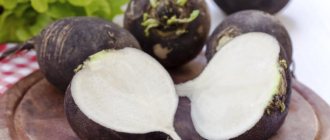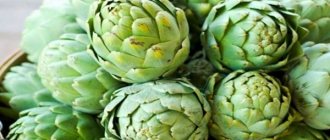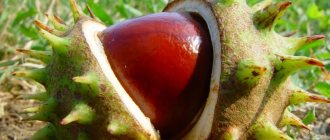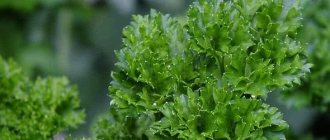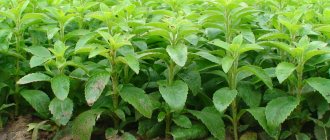Author: Natalya Category: Garden plants Published: June 30, 2016Republished: February 28, 2019Last edits: January 6, 2021
- Daikon planting dates
- How to grow daikon
- Daikon processing
- Useful properties of daikon
The daikon vegetable, or Japanese radish, or Chinese radish, or Japanese daikon, is a root plant of the Cruciferous family, a subspecies of radish, which, unlike radishes and radishes, does not contain mustard oils and has a very mild odor. This variety was obtained by the Japanese through selection back in ancient times from the loba plant, which belongs to the Asian group of radish varieties growing in China. Translated from Japanese, daikon means “big root.” Daikon radish is one of the most important ingredients in Japanese cuisine, used in salads, soups, and side dishes in fresh, boiled, stewed and pickled form. The Chinese cook daikon radishes with shiitake mushrooms, while the Koreans and Burmese love salted daikon. Eastern Europeans know the daikon root vegetable as “white radish” or “white radish”; it is served in salads with butter, sour cream or cream.
Planting and caring for daikon
- Planting: sowing seeds in open ground - in July or August; sowing seeds for seedlings - in the second half of March, planting seedlings in the garden - at the stage of forming two pairs of true leaves.
- Lighting: bright sunlight.
- Soil: loose, sandy loam and light loamy soils of neutral reaction in areas with deep groundwater.
- Watering: regular and sufficient: the soil on the site must be kept slightly moist at all times. The first watering is after the emergence of seedlings, then the soil is moistened once every five days, and in dry times even more often.
- Feeding: twice during the growing season: in the phase of formation of 4-5 leaves - with a solution of 3 spoons of Azofoska in 10 liters of water, during the formation of root crops - with a solution of one spoon of superphosphate and two spoons of potassium salt in 10 liters of water.
- Reproduction: seed - seedlings and non-seedlings.
- Pests: cruciferous flea beetles, garden cutworms, sprout and spring cabbage flies, rapeseed bugs and flower beetles, slugs, cabbage bugs, aphids and moths.
- Diseases: clubroot, blackleg, vascular bacteriosis, mosaic and felt disease.
Read more about growing daikon below.
conclusions
Having analyzed in detail how to plant daikon seeds in open ground, what are the sowing time and cultivation characteristics, we conclude that such an unpretentious, tasty and healthy plant should certainly settle in the garden or dacha. Especially if the site is located in the Urals or in a cold climate zone. After all, there are few garden crops there that can be obtained in the garden beds as a “second echelon”, and you can enjoy vitamin-rich and tasty root crops until spring.
Author: Maria
Source: mainavi.ru
in open ground, daikon, planting
Daikon radish - description
Daikon is an annual or biennial plant. During the growth process, it forms a rosette of 12-40 heavily dissected leaves and root crops, larger than those of radish, and weighing from 600 g to 4 kg, although sometimes fruits weighing up to 20 kg are found. In addition, they are more juicy and tender, without any sharpness. Daikon has good shelf life and is successfully grown in the middle zone. The vegetative period of daikon, depending on the variety, is from 40 to 200 days.
Daikon is a relative of plants such as cabbage, radishes, turnips and other lesser-known cruciferous plants. In recent years, thanks to its unpretentiousness and high yield, this plant has become almost as popular among gardeners as the root crops we are used to, carrots and beets. We are ready to tell you when and how to plant daikon seedlings, when to plant daikon in the Moscow region, how to grow daikon radish, which plant varieties are most adapted to the conditions of the middle zone, as well as what are the benefits of daikon and what and for whom it can be harmful daikon
The most common varieties
Before we master the cultivation of daikon, we will analyze the varieties, planting and care . In the retail trade, plant seeds are presented in a wide range. Conventionally, they are divided into 3 main groups: early, mid-early (mid-season), late.
Table No. 1 Classification of varieties by ripening time
Varieties by ripening time | Name | Period from sowing to ripening (in days) | |
| 1 | Early ripening | Early Long White F1, Shirogari, Minowashi, Sasha, Tsukushi spring cross | 40 – 60 |
| 2 | Mid-season | Elephant Tusk, Red-mid, Moscow Bogatyr, Caesar, Dragon, Bludgeon | 60 – 80 |
| 3 | Late ripening (for winter storage) | Japanese, Nerima | 80 — 110 |
The varieties differ:
- by yield,
- the size of the fetus,
- taste qualities.
For example, Elephant Tusk has the maximum yield, Early Long White can be easily stored from autumn to March, but Red Mead is round in shape, when cut the flesh is two-colored - greenish at the edges and pinkish closer to the center. The larger the vegetable, the sweeter and juicier it is. This feature is inherent in all varieties of Japanese radish without exception.
Growing daikon from seeds
Sowing daikon seeds
For the most part, daikon varieties with round or short oval root crops are grown using seedlings, since varieties with long root crops do not tolerate replanting, much less picking. When to sow daikon? Sowing is carried out from mid-March to early April. Before sowing, daikon seeds must be heated for 20 minutes in water at a temperature of 50 ºC, then immediately cooled in ice water, and then placed in the vegetable drawer of the refrigerator for a day.
- Selecting a method for soil deoxidation
It is best to sow 2-3 daikon seeds in peat tablets or peat-humus pots, along with which, when the time comes, the seedlings are transplanted into the garden bed. But if you are planning to grow seedlings in a box or container, then keep in mind that the depth of the container should be at least 10 cm, since daikon has a long root. Sow the seeds in well-moistened, loose, light soil to a depth of about 2 cm, after which the crops are covered with film or glass and placed in a warm place.
Growing daikon seedlings
Under favorable conditions, seedlings may appear after 5 days, and then the covering should be removed. Caring for daikon during the seedling period consists of moistening and loosening the soil as needed. When the seedlings develop the first pair of leaves, they are thinned out, pulling out weak and sluggish seedlings so that they do not take away nutrition from stronger and more developed ones. After thinning, the seedlings are fed with mineral fertilizer in low concentration. Make sure that the daylight hours of the seedlings are not too long, otherwise, instead of increasing the volume of the root crop, the plant will begin to bloom.
If you are going to plant seedlings in a greenhouse, it is best to grow them on a glassed-in loggia, but if you are preparing seedlings for open ground, start hardening procedures two weeks before planting: take the seedlings outside every day for a while, gradually increasing the duration of these sessions until seedlings will not be able to spend the whole day in the fresh air.
Description and characteristics of the variety
The ultra-early ripening variety has the following characteristics:
- stable in yield. Up to 4.5 kilograms of high quality fruits are harvested per square meter;
- the plant rarely produces arrows. Therefore, it is possible to sow several times per season;
- has high nutritional value;
- technical maturity occurs after 35-45 days. Under favorable weather conditions, the ripening period can be reduced to one month;
- long-term storage. It can be stored for 3 months without loss of taste and commercial qualities;
- cold-resistant variety;
- resistant to mucous bacteriosis;
- Suitable for growing in any region of the country.
Description:
- The radish looks like a huge carrot. The average length is half a meter. Weight can reach 500 grams. The minimum weight of root vegetables is 200 grams. Diameter – 10-11 centimeters;
- suitable for boiled, salted and fresh consumption;
- the taste is delicate, without bitterness. The fruits are juicy;
- Not only root vegetables are suitable for consumption, but also the leaves of the young plant;
- the flesh is pale white;
- Half of the fruit is located above the soil surface, which facilitates rapid harvesting.
Planting daikon in open ground
Daikon planting dates
When to plant daikon in open ground? When the seedlings develop two pairs of true leaves. The timing of planting daikon in the garden is closely related to the climate of your area and the length of daylight hours, which during the formation and development of the root crop should not be longer than 12-15 hours. With longer daylight hours, daikon can shoot. The air temperature at the time of transplanting seedlings into open ground should not be lower than 10 ºC. Choose the sunniest place for your garden bed.
Soil for daikon
Daikon is not picky about soil composition, but it grows better on neutral and loose light loamy or sandy loam soils with low groundwater levels, although there are varieties that grow well even on heavy clays. If the soil in your chosen area is acidic, add lime to it. The optimal soil pH for growing daikon is pH 6.0-8.0.
You need to prepare the area for daikon in the fall, even if you are planning to plant it in the spring: dig the soil to the depth of a spade bayonet, while simultaneously adding 1-2 kg of compost or humus, 20 g of potassium sulfate and ammonium sulfate and 40 g of superphosphate. Do not add lime to the soil at the same time as fertilizer; do it two weeks earlier. And it is better to add organic matter not before planting daikon, but under the previous crop.
By the way, it is good to grow daikon after crops such as potatoes, cucumbers, tomatoes, beets and carrots.
And the worst predecessors for daikon are all representatives of cruciferous vegetables - cabbage, turnips, radishes and turnips.
How to plant daikon in open ground
Planting daikon in open ground is carried out according to a 30x60 cm scheme, that is, there should be at least 30 cm between plants in a row, and 60 cm between rows. The seedlings are planted in moistened soil, which after planting is lightly trampled down and mulched on top with peat. If you have concerns that night frosts may return, cover the bed with daikon with polyethylene or other covering material for the first time.
Planting daikon before winter
Pre-winter planting of daikon is convenient because you can use areas for it after harvesting early crops such as dill, lettuce or onions. In addition, due to the decreasing daylight hours, the possibility that the daikon will begin to bloom instead of growing a root crop is minimized. But autumn planting also has a drawback: root crops may not have time to reach their maximum size.
Before sowing, do not forget to prepare the soil in the beds and process the seed. Actually, autumn planting of daikon cannot be called pre-winter planting, since it is carried out at the end of July or beginning of August, although in the southern regions sowing can be carried out even in September. Daikon is sown in well-moistened soil, 2-3 seeds in each hole, which are dug at a distance of 30 cm from each other with row spacing 60 cm wide. The depth of planting the seeds in the soil is 1.5-2 cm. After planting, the bed is mulched with peat.
When the seedlings appear, they are thinned out, leaving the most developed sprout in each nest. It’s just better not to pull weak shoots, but to pluck them out so as not to damage the root crop of a strong seedling.
Selecting a site for planting
The variety is not picky about soil composition. But the best harvest of root crops is harvested on light soils fertilized with humus or compost.
Ideal place for daikon after:
- salad;
- peas;
- early potatoes;
- Luke;
- alfalfa;
- green manure;
- lupine;
- dill;
- early varieties of cucumbers;
- parsley
See also
Simple recipes on how to properly freeze fresh radishes for the winter and is it possible to do this?
Read
Ideal soil:
- sandy;
- light loamy chernozem;
- sandy loam;
- forest gray;
- podzolic;
- light chestnut;
- chestnut.
The soil is prepared in the spring. They dig it up and add a mixture of:
- buckets of humus;
- 30 grams of complex mineral fertilizer.
This amount is distributed per square meter of beds.
Daikon care
How to grow daikon
Planting and caring for daikon is simple and not labor-intensive. Daikon in open ground needs regular watering, loosening the soil between plants, weeding, fertilizing if you are growing daikon in infertile soil, and protection from diseases and pests. In addition, daikon needs to be hilled, because as it grows, its root crop begins to peek out of the ground, sometimes up to a third of its length.
- Growing cucumbers on the balcony with seedlings
Watering daikon
The key to a good harvest is regular and sufficient watering of the daikon. Planting should be kept slightly moist throughout the growing season. The daikon is watered for the first time after germination. If the plant lacks moisture, it may wilt, and the pulp of already formed root crops will become coarse, acquire a bitter taste and an unpleasant odor. If watering is not carried out regularly, root crops crack and their ability to be stored for a long time is reduced.
The frequency of watering daikon is approximately once every five days. If there is a drought, you will have to moisten the bed more often, but if it rains, sometimes you can skip watering.
What you can and cannot plant daikon next to
There are various tables of correspondence between garden and vegetable crops, based on the similarities and differences in agricultural technology, as well as on the nature of the main diseases and pests. For example, it is well known that onions and carrots get along well in the same bed, since they mutually kill the enemies of their neighbors - onion and carrot flies.
For daikon, onions are considered a good neighbor, as they drive away cruciferous flea beetles and butterflies with their phytoncides. Other friendly crops:
- carrot,
- beet,
- any pumpkin crops: zucchini, squash, pumpkin, cucumbers.
Daikon should not be planted next to the following plants:
- peas,
- any type of cabbage,
- strawberry.
Video: mixed plantings of daikon and other crops
Pests and diseases of daikon
With improper care and violation of agricultural practices, daikon suffers from the same diseases as other members of the cruciferous family. If you overdo it with moistening the area, the daikon may be affected by mucous bacteriosis, a disease whose symptoms appear mainly in the second half of the growing season. As a result, the daikon root softens and darkens. Sometimes symptoms of the disease in the form of pockets of wet rot can be noticed already in the storage.
In addition to mucous bacteriosis, daikon can become ill with diseases such as clubroot, blackleg, vascular bacteriosis, mosaic and felt disease. To avoid problems with fungal and viral diseases, it is necessary to use protective measures such as:
- compliance with crop rotation and agricultural technology;
- growing fungus-resistant varieties;
- pre-sowing seed treatment;
- control of weeds and pests, which are often carriers of viral diseases for which, alas, there is no cure;
- disinfection of storage facilities;
- clearing the area of plant residues and destroying them.
Of the pests, the most dangerous pest for young daikon is the cruciferous flea beetle, but there are other enemies: the cutworm, sprout and spring cabbage flies, rapeseed bugs and flower beetles, slugs, cabbage bugs, aphids and moths.
Daikon processing
In the fight against fungal diseases, the best results are achieved by preventive measures, but if the disease does affect the plant, you will have to resort to radical procedures - treating the area with biological products Binoram or Planriz in accordance with the instructions. There is no cure for mosaic, so immediately remove the diseased plant from the area and water the hole with a strong solution of potassium permanganate.
Measures must be taken against the cabbage flea beetle immediately after sowing the seeds: the area is sprinkled with coarse ash. After the seedlings emerge or the seedlings are planted in the ground, the bed is sprinkled with fine ash.
Treatment of plants with an infusion of red hot pepper is effective against other insects: five pods are poured with a liter of hot water, infused for 12 hours, then filtered and diluted with water to an amount of 10 liters. If after one treatment not all insects died, repeat spraying after 3-4 days. To destroy the larvae, daikon is watered with a weak solution of potassium permanganate.
Flies are repelled by the smell of marigolds, which can be planted around the perimeter of the daikon bed, and the appearance of slugs can be prevented by a ditch with ash dug around the area.
Daikon Sasha: description of the variety
Daikon Sasha: photo
Daikon first appeared in Japan and is currently one of the most popular crops in this country. Daikon is also widespread in India, Thailand, America and in parts of Europe. The root crop was brought to our country at the end of the nineteenth century. Daikon quickly became popular. It does not contain mustard oils and has a soft, delicate taste. Daikon is sometimes also called white radish or sweet radish. If you follow the correct agricultural practices for this crop, you can achieve excellent yield results, and your fruits will grow crispy, large and juicy. The Sasha variety appeared relatively recently. It has a high level of productivity, so it quickly caught the fancy of summer residents. Sasha also has good resistance to cold temperatures, ripens quite quickly, and is also well stored and does not lose its properties.
It must be admitted that most of the varieties grown by the Japanese are not suitable for the climatic conditions of Russia. For this reason, our breeders have come up with a large number of varieties that are adapted to our realities. The Sasha variety officially appeared in the State Register in 1994. Daikon Sasha grows best in the middle zone, but in general it is suitable for other regions of the country.
Daikon variety Sasha belongs to the Brassicaceae (Cruciferous) family. The fruit has a round shape. Sometimes it is elongated or flattened. The size of root vegetables varies, usually from five and a half centimeters to eleven centimeters in length. In its middle, the root crop usually has a diameter of five to ten centimeters. The surface of daikon usually has a smooth texture. The color usually has a slight yellowish tint. The inside of the daikon is white, its texture is dense, it crunches well, and usually has no voids.
The taste of daikon is slightly sweet with a noticeable spicy component. Has a delicate aroma. Daikon foliage is green and shaped like a lyre. The surface has slight pubescence. The leaf length is usually from 30 to 55 centimeters. The leaves are grouped in a rosette.
Cleaning and storing daikon
Depending on the variety, daikon is harvested 40-70 days after sowing. Autumn-planted daikon is harvested in October, before the onset of persistent cold weather. Do not keep root vegetables in the ground, as they may bloom or lose their taste. Choose a dry, sunny day for cleaning.
Daikon, growing in light soil, is pulled out by the tops, and from heavy soils, root crops have to be dug up with a shovel or removed with a pitchfork. Root crops extracted from the ground are laid out along the bed to dry, then they are cleared of soil, the tops are cut off and the root crops are lowered into the cellar, where they will be stored in boxes with sand at a temperature of 0 to 5 ºC, without touching each other. In such conditions, daikon root vegetables can remain until the New Year holidays.
Varieties and hybrids
During the selection process, more than 700 varieties and hybrids were created, differing in early ripening, shape and size of the fruit, and immersion in the soil. For central Russia, varieties recommended for greenhouses are Sasha, for open ground:
- Bludgeon;
- The Dragon;
- Caesar;
- Favorite;
- Minowasi;
- Moscow hero.
Table. Characteristics of daikon varieties and hybrids
| Variety | Fruit weight (kg) | Form |
| Early ripening – growing season 30–60 days | ||
| Sasha | 0,1–0,4 | Round, round-oval |
| Rhinoceros | 0,3–0,4 | Conical |
| Vakula | 0,4–0,8 | Cylindrical |
| Barchonok | 0,4 | Round |
| Misato Pink Glitter | 0,5–0,9 | Round or flat-round |
| Mid-early with a growing season of 60 to 70 days: | ||
| Mino Same Cross F₁ | 0,4–0,5 | Conical |
| Caesar | 0,6–1,0 | Cylindrical |
| Autumn handsome | 0,3–0,42 | Elongated elliptical |
| Diamond | 0,23 | Round |
| Dubinushka | 0,6–2,0 | Cylindrical |
| Favorite | 0,5–0,6 | Conical |
| Mid-season – 70–85 days | ||
| Emperor F₁ | 0,5–0,6 | Icicle-shaped |
| Elephant Tusk | 0,3–0,6 | Elongated cylindrical |
| The Dragon | 0,9–1 | Cylindrical |
| Moscow hero | 1,0–1,5 | Cylindrical |
| Mid-late 86–90 | ||
| Minowasi PC | 1,0–1,5 | Cylindrical |
Early ripening varieties, such as Sasha, Barchonok, Rhino, are sown in two periods - in April in a greenhouse, in open ground in the 2nd decade of July. The most resistant to flowering are the Minovasi and Sasha varieties.
Daikon seeds can be purchased in specialized stores or ordered from online stores. The cost of 1 g of seeds in Moscow and St. Petersburg - depending on the variety and quantity - is from 16 rubles per 1 g. 1 g of seeds contains from 90 to 140 pieces.
Daikon varieties
Daikon varieties are classified taking into account the shape of the root crop and the depth of its immersion in the soil. For example:
- a group of Nerime varieties with white, long (from 40 to 70 cm), smooth, spindle-shaped and very juicy fruits with a diameter of 8-10 cm, buried in the ground a quarter or a third of the length;
- Miyashige hybrids, very popular in Japan, with cylindrical root crops 35-50 cm long and 7-9 cm in diameter, buried 2/5 or ½ of the length into the soil;
- Shogoin varieties that are not as productive, but grow well in heavy clay soils, with round and flat-round fruits with a diameter of 15 to 20 cm, immersed in the ground by a quarter or 1/5 of the length;
- a group of early ripening varieties of Sirogari with cylindrical root crops 25-30 cm long, 6-7 cm in diameter, buried 2/3 or ¾ of the length into the soil. The growing season of daikon of these varieties is about 55 days;
- a large group of early-ripening, heat-resistant and disease-resistant varieties Minowase (Minovasi) with root crops that are cylindrical in the upper part and elongated-conical in the lower part. The length of the root crops is from 40 to 55 cm, the diameter is 7-8 cm, immersed in the ground by ¾ of the length. The Minowashi daikon prefers light sandy loam soils. Planting and caring for the Minowashi daikon were described in our article;
- varieties of the Nineigo group are represented by root crops completely immersed in the soil, cylindrical in the upper part and elongated-conical in the lower part, the length of which reaches 40-60 cm and the thickness of 5-6 cm. Varieties of this group love light soils and are resistant to bolting and frost;
- Kameida is a group of varieties with conical root crops only 12-15 cm long and 1 to 5 cm thick, buried 2/3 of the length into the ground. In addition to root vegetables, which have a pungent taste, leaves of the Kameida variety are also eaten. These varieties also prefer light soils.
Daikon varieties are also divided according to the growing season into spring (early), summer (mid-season) and autumn (late). We offer you several unusual varieties, even for such an outlandish vegetable, so that you can choose among them the best daikon for your garden:
- Daikon Sasha is an early ripening variety of medium yield, zoned for the middle zone. The growing season for plants of this variety is from 35 to 45 days, the root crop is large, white, only half immersed in the ground. The pulp of the root vegetable is juicy, crisp, snow-white, slightly greenish at the surface, with a moderately pungent taste. Planting and caring for daikon Sasha is not labor-intensive, but it has one drawback - its root crops are not all the same size;
- Pink glitter misato is a Japanese variety with a delicate pink sheen on the cut of the root crop. The problem is that if you plant this daikon in the spring, it may shoot out, and if you plant it in the fall, the fruits will turn out small. This variety is unlikely to be suitable for cultivation in the middle zone; it is better to cultivate it in the southern regions;
- Dubinushka is a mid-season variety, resistant to mucous bacteriosis, with white root crops, reaching a length of 60 cm and a weight of 3-4 kg under optimal conditions. The pulp of root vegetables is white, juicy and sweet;
- Dragon is a mid-season productive variety with a conical, smooth root crop. This is a white daikon with a length of 30 to 60 cm, a diameter of 6-8 cm and a weight of up to 1 kg. The pulp of plants of this variety is sweetish, very tender, juicy, but dense, distinguished by high taste;
- Flamingo is a mid-season productive and flower-resistant hybrid with a medium-sized smooth purple-pink-white icicle-shaped root crop with pink flesh. The depth of immersion in the soil is 2/3 of the length. Root weight 600-800 g;
- Tsukushi spring cross is a productive, early-ripening hybrid that is resistant to bolting. The root vegetables of this variety are white, smooth, cylindrical in shape, weighing up to 800 g. The pulp is white, tender and juicy. The root crop is easily removed from the ground.
In addition to those described, the varieties Caesar, Favorite 9908099, Japanese White Long, Tokinashi, Big Bull, Elephant Tusk, Aokabi-daikon, Sakurajima and others grow well in our area.
- How and when to plant onions for seedlings in 2021
Features of planting daikon varieties Sasha and Minowasi
Currently, there are a large number of daikon varieties, not only of Japanese origin, but also of Russian selection. Perhaps the most popular are the imported representative Minovasi and the domestic one - Sasha. They differ quite greatly from each other both in appearance and in optimal growing conditions.
Daikon variety Sasha
It is believed that daikon Sasha has increased resistance to bolting. However, if the summer sowing is too early, it will still respond poorly to long daylight hours. But due to its high early maturity, when sown at the very beginning of August, it manages to form high-quality root crops in any climatic conditions. Even under the most unfavorable conditions, its growing season does not exceed one and a half months, and with good care, the harvest is ready 30 days after germination.
Sasha’s root vegetables are not very large (weighing from 200 to 400 g and about 10 cm in diameter), they look more like an ordinary white radish. In the full ripening phase, approximately half of the fruit rises above the soil surface. The taste of the dense crispy pulp is characterized as excellent, without bitterness, which allows it to be used in dietary and even baby food.
Sasha takes up little space, it does not have a very high yield, but it is tasty and ripens very quickly
This variety can be grown both in open ground and in a greenhouse. Due to its ultra-earliness, Sasha can be sown not only in late summer for autumn consumption, but also in early spring, at the same time as regular radishes. There is no point in growing it through seedlings. However (from the point of view of the temperature background), Sasha does not really like serious fluctuations in day and night temperatures (the pulp of the root crop becomes coarser), therefore, in those periods and in those climatic zones where this is possible, the timing of its sowing, both spring and late summer, should be adjust.
When planting daikon Sasha in summer, you can sow it between the rows of onions that have not yet been harvested, but are almost ready, thereby killing two birds with one stone:
- on the one hand, space will be saved (and in the first week and a half this daikon does not take up much space);
- on the other hand, the onion smell will repel pests from the young foliage of the daikon.
Since this variety does not form very large plants, it can be sown thickly: a distance of 15–20 cm is sufficient between the seeds, about 25 cm between the rows. However, it is usually sown much more often, and as the seedlings grow, they are thinned out: the young foliage of daikon adds piquancy to any summer salads.
Two weeks after germination, the daikon Sasha begins to form a root crop, therefore, if not all thinning has been carried out by this point, the specimens pulled out later can be chopped into salads along with the roots.
Daikon variety Minowashi
This mid-season Japanese variety, included in the State Register of the Russian Federation, stays in the garden for about two and a half months. The cylindrical root crops grow very long, weighing up to 1.5 kg, and are characterized by excellent taste. Has increased resistance to shooting. Since Minowasi forms a long root in the first weeks of its development, it is almost impossible to grow it through the seedling stage (this simply requires very deep pots).
Minowashi - daikon of a “classic” shape, long, one of the most delicious varieties
Minowasi can be sown immediately with seeds in a greenhouse or open ground. Due to the rather long growing season, spring cultivation in the middle zone is possible only in a greenhouse, where it is planted at the very beginning of April or a little earlier. You can also try sowing in the garden (at the end of April), but it is better to choose earlier ripening varieties for this, and leave Minovasi for autumn consumption and sow in the second half of July.
The plants of this variety are quite large, so the minimum possible distance when planting is 30x60 cm. In addition to these distances, one should also take into account the fact that the root crop penetrates into the ground to a considerable depth. Therefore, if the fertile layer is small, before sowing in the intended places, experienced gardeners make a hole with a crowbar to a depth of at least half a meter and add local fertilizers there (a liter jar of compost, a little ash, a teaspoon of azofoska). Then the hole is filled with soil and daikon is sown in the usual way.
In the second half of July, Minovasi is planted after harvesting onions or garlic, adding full mineral fertilizer to the bed. The processes of sowing and caring for Minowasi do not differ from those for other varieties, but harvesting must be done very carefully: the long root crops are very fragile, sometimes, in order not to break them, you have to dig them up almost like garden shrubs.
Video: Minowasi daikon harvest
Daikon is a healthy and tasty vegetable, its root crops are striking in their size, and their agricultural technology is simple. In fact, to successfully grow daikon, only two conditions are needed: timely sowing and abundant watering. Therefore, obtaining a decent harvest of this Japanese radish is within the capabilities of anyone, even a beginner, summer resident.
- Author: Semyon Vladimirov
Rate this article:
- 5
- 4
- 3
- 2
- 1
(1 vote, average: 4 out of 5)
Share with your friends!
Properties of daikon - harm and benefit
Useful properties of daikon
Daikon is a low-calorie product with a high content of vitamin C. Moreover, the plant contains an enzyme that promotes the digestion of starches. That is why daikon is recommended for people struggling with excess weight.
Daikon also contains phytoncides that help the body cope with various types of infections, potassium salts that remove excess fluid, toxins and waste from the body, as well as substances necessary for the normal functioning of metabolism and the absorption of carbohydrates, fats and proteins - esterase, amylase and enzymes . In addition, daikon contains magnesium, phosphorus and iron salts, fiber and pectins, a large amount of beta-carotene and B vitamins.
Daikon is indicated for the treatment of atherosclerosis and cardiovascular diseases. Eating daikon raw helps eliminate radiation, excess cholesterol and increases appetite. Drinking a glass of daikon juice before meals, due to the sulfur it contains, has a beneficial effect on the functioning of the liver and gall bladder. As an antiviral and antibacterial agent, daikon juice is recommended for use for respiratory diseases - asthma, colds, bronchitis, chronic cough and flu.
200-300 g of grated daikon will help cope with a hangover. And external use in the form of compresses and lotions accelerates the healing of festering wounds, strengthens hair and gets rid of freckles.
Daikon - contraindications
Daikon may cause discomfort to people with gastrointestinal problems because it contains a large amount of fiber, which, if digested, can cause indigestion and flatulence. Daikon is harmful to people with ulcers and people suffering from hyperacid gastritis or gout, as well as those with impaired kidney function. People over fifty years of age should consult a doctor before consuming daikon.
Appearance and properties
Root crops reach gigantic sizes, do not take heavy metal salts and radioactive elements from the soil. The taste is soft, juicy, with a mild aroma, without pungency or bitterness, as they do not contain mustard oil. The composition is rich:
- peptides. The polysaccharide stabilizes blood sugar and cholesterol levels and has an anti-cancer effect;
- vitamins of group C, PP, B;
- phytoncides, which relieve fatigue, normalize blood pressure, increase the body's resistance and performance;
- enzymes. Enzymes accelerate metabolic processes, improve the bioavailability of food, prevent rotting and stagnation throughout the gastrointestinal tract;
- micro- and macroelements: phosphorus, iodine, selenium, magnesium.
Gardeners have already managed to appreciate the low-calorie and pleasant taste of the product, the possibility of consumption without heat treatment. Salads that are suitable for people losing weight are prepared from it. The root vegetable is boiled, fried, stewed, baked in the oven. The tops are not used for food in all varieties; more often only the underground part of the radish is used.
Daikon Sasha: characteristics
The Sasha variety is early ripening, even very early! Just imagine, the fruits reach their ripeness in just thirty-five to forty-five days. If the weather is suitable, the root vegetables can be harvested within a month! Many experienced gardeners, taking advantage of this property, grow not one crop in one season, but two or even three. As a rule, about 2.5 kilograms of daikon are harvested from one square meter. This is from an open area. And in greenhouse conditions you can achieve a yield of four to five kilograms. As a rule, one fruit reaches two hundred to four hundred grams in weight. When the daikon reaches its full maturity, it can be said to “climb out” from the ground. This makes collecting it much easier.
Daikon bears fruit well if the soil is sufficiently fertilized. Prefers not heavy, neutral soil.
Sasha may be attacked by harmful insects or become infected with diseases. The list of pests and diseases is standard for all crops that are classified as Cruciferous. To avoid such problems, it is better to carry out the necessary preventive procedures, and also do not forget about weeding and loosening the soil.
After planting daikon once, you should not plant the same crop again in the same place, as there is a risk of disease.
This variety has many good qualities. It produces a good harvest at a stable level and is not fussy in its care. If you have a greenhouse, you can grow Sasha throughout the year. Daikon has a good shelf life. Root vegetables ripen very quickly, and Sasha daikon seeds can remain viable for up to eight years! This variety does not place high demands on the soil and is perfect for children. Daikon Sasha is not characterized by early formation of stems.
There are also some disadvantages to the daikon variety Sasha. So, for example, this crop needs stable watering, otherwise there is a risk that Sasha will begin to bloom, and the quality of the root crops will deteriorate. If sudden temperature changes occur, the structure of the pulp becomes worse, coarser and too dense. The fruits do not have a uniform size; both small and large root crops can be found. If care rules are not followed, the root vegetables may crack.
Selection of daikon planting material
There are many varieties of daikon, both domestic and native to Japan. Their choice depends on whether you are going to store the daikon or eat it straight away. If the appropriate conditions are created, some varieties can be stored for up to six months. In the middle zone, a good harvest can only be obtained by sowing early and mid-ripening varieties. Late ripening ones simply will not have time to form a large harvest. For loose, light soils, daikon varieties with any size of root crop are suitable; on heavy, dense soils, it is better to take those that produce a small oval or round vegetable.
About harmful insects, daikon diseases and control methods
The daikon variety Sasha is attacked by pests and diseases quite infrequently. If it so happens that the plant gets sick with some kind of infection, then Bordeaux mixture and copper sulfate can come to the rescue. From time to time, inspect your plants for signs of diseases and take appropriate measures in a timely manner. If the situation is advanced, then you will have to get rid of almost the entire crop and even change the land.
Do not allow your planting to become too thick; the temperature and humidity should not be too high.
Slurry can be used as pest prevention. You can also use tobacco infusion, mustard infusion
